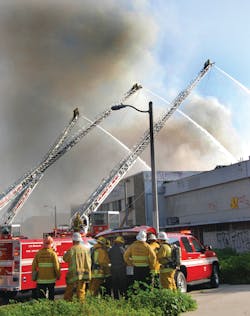A while back, we overheard a firefighter refer to the brass on the collar of a chief officer as “plungers.” Freely admitting that it took us aback for a moment, we still wanted to know what the firefighter meant by his comment.
The firefighter explained that the chief wore brass plungers on his collar to signify how much power he had to force some mandate or decree upon people – and more plungers mean more power. It is plausible that if you look at the brass collar pins that fire officers wear, they can appear to look like plungers – the tool we use to force “material” down small openings. Obviously, his remarks were meant to be demeaning, but his perception may have some truth.
On the flip side, we’ve also heard it mentioned in the officer ranks that the number of plungers on one’s collar coincides with the amount of “material” the officer has to deal with. Following this logic, the lieutenant has to put up with one level (firefighters) and so on and so forth all the way up to the chief, who is said has to put up with the most “material” of all.
Bugles, or speaking trumpets, were first used by fire chiefs in New York City in 1853 to better communicate to firefighters on the fireground. In time, bugles began to be used as symbols to signify rank; more bugles meant that officers had more influence or power within the organization. Today, lieutenants have one bugle and fire chiefs have five bugles, as examples. The key here is that bugles were originally used to communicate to others.
So how did bugles morph into plungers, at least as perceived by some in the fire service? Most likely, it happened over a long period and as a result of how messages were given. If people feel like information or communications are forced on them, then something is being done wrong. All of this comes down to how power is wielded and how people are treated. What is needed here is a short lesson in leadership.
Types of Power
The currency of leadership is influence. A leader needs followers, and the reason people will follow you is because you have influence on them. Influence is power, not in the traditional sense of energy in action, but in the sense that your position power, or personal power, can cause the follower to do something.
Power, then, comes in five types. The first three types are grouped in what is called “position power.” These types of power come from your formal position within a group, organization or community. They include legitimate power, coercive power and reward power. The remaining two types fall under the category of “personal power.”
Legitimate power is derived solely from your position. A fire chief has legitimate power when he or she asks you to complete a task. Because that person is the chief, you’ll most likely do what he or she asks. Even the most unpopular chief gets a certain amount of respect merely because of being the chief – this is legitimate power in its most basic form. Another example of legitimate power is on the fireground, where the incident commander has supreme power over all others – based solely on holding that position.
The second category of position power is coercive power. The same chief that we spoke of earlier also has coercive power because he or she can make life difficult for you if you do not do what he asks. The chief can threaten you with insubordination or even send you home without pay. By virtue of his or her position, the chief has this coercive power over you and you’ll most likely do what the chief wants done.
Conversely, the chief also has the ability to reward you to complete an order. This is known as reward power, where an “If you do this, I’ll give you that” relationship is pre-agreed upon (either formally or informally). The chief could reward you with a special assignment or duty, promote you or even grant you overtime through reward power.
The problem with the position power types is that, while they can be effective short-term motivators, they are not very effective in the long run. There is a mountain of evidence that suggests that people grow tired of these power types and they grow resentful of those who use them. People will tend to follow leaders who use these power types only as much, and as far as they have to, for survival. As a position-based leader, you will eventually start to lose your followers and then you will become ineffective as a leader.
From a communication standpoint, the use of position power is one-sided. That is, legitimate, coercive and reward power are all used by the leader and the power is subjected upon the follower. Certainly, the followers have a choice; they can refuse the order and pay the consequences or they can also knuckle under and do what is ordered. Either way, the followers are going to walk away resentful and thus these power types are not effective when used.
Using Power Effectively
The most effective use of power types rests with personal power. These types include both expert power and referent power. Expert power influences people through knowledge and skills in areas that others do not have. A chief officer with superior knowledge of fire strategy and tactics, for example, will have a great deal of expert power with firefighters. A person does not need to have position power to have expert power. For example, while everyone will listen as the lieutenant discusses water supply, it’s the skilled pump panel operator who will swing the big bat in the drill session. Numerous studies point to this power source as being very effective on influencing others. Keep in mind though, that the scope of power for the expert lies within his or her area of expertise. While the aforementioned chief may be revered for superior strategic fireground skills, he or she may also not be able to locate the power switch on the computer – thus would not wield the same power in a discussion on computer software.
The other very effective personal power type is referent power. This power source comes from developing relationships, getting to know people and developing trust. It can even be derived from a person’s appearance. Substantial evidence suggests that people follow those that they like, trust and are attracted to. With all of this, leaders do well to develop a positive demeanor and foster good relationships.
The key in developing and using the personal power types of expert and referent power rests in genuine and effective communication. If fire officers can effectively communicate with firefighters and maintain strong and productive relationships, then they can have a great deal of influence on their followers. It is all about communication and how the leader uses their influence. Peter Drucker, the leadership and management authority, said, “Organizations are no longer built on force, but on trust.” Modern leaders will embrace this truism and focus their efforts on forging trusting relationships. In essence, mutual trust is the new currency of leadership.
The best examples of this communication and trust dynamic can be found in your own past. Most likely, if you think about your favorite chief officers, it was because they were genuine, trustworthy and communicated effectively. They knew their jobs and took the time to pass that information on to you. They probably treated you with respect, they were fair, they were mentors and their actions showed that they cared about you. In other words, they probably had expert and referent power with you, and you most likely trusted them.
Positive Communication
Where this all comes full circle is how the bugles are used. Most assuredly, if communication flows only one way to force mandates and actions upon subordinates, there will be resentment and pushback. While things will get done because of fear, personnel will not be loyal followers. Worse yet, they will avoid leaders who resort to these old, staid forms of ordering people to do things. People working under the force of a plunger will not be motivated to do anything other than the minimum – and they may even jump ship at the first opportunity. However, if the bugles are used as they were originally intended, to communicate to followers, then an environment of caring, trust and authenticity is better able to develop. Then, followers will generally be favorably influenced, especially if they were also listened to. Other byproducts of exercising these personal power sources are more motivated and engaged employees, better up and down communications and a better-served public.
Think about how you want to exert your leadership influence. Hopefully, you use your bugles to communicate effectively and not as plungers to force anything unduly on others.






